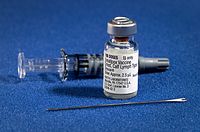
Photo from wikipedia
Vaccines are prophylactics used as the first line of intervention to prevent, control and eradicate infectious diseases. Young children (before the age of six months) are the demographic group most… Click to show full abstract
Vaccines are prophylactics used as the first line of intervention to prevent, control and eradicate infectious diseases. Young children (before the age of six months) are the demographic group most exposed to recommended/mandatory vaccines preserved with Thimerosal and its metabolite ethylmercury (EtHg). Particularly in the less-developed countries, newborns, neonates, and young children are exposed to EtHg because it is still in several of their pediatric vaccines and mothers are often immunized with Thimerosal-containing vaccines (TCVs) during pregnancy. While the immunogenic component of the product has undergone more rigorous testing, Thimerosal, known to have neurotoxic effects even at low doses, has not been scrutinized for the limit of tolerance alone or in combination with adjuvant-Al during immaturity or developmental periods (pregnant women, newborns, infants, and young children). Scientific evidence has shown the potential hazards of Thimerosal in experiments that modeled vaccine-EtHg concentrations. Observational population studies have revealed uncertainties related to neurological effects. However, consistently, they showed a link of EtHg with risk of certain neurodevelopment disorders, such as tic disorder, while clearly revealing the benefits of removing Thimerosal from children's vaccines (associated with immunological reactions) in developed countries. So far, only rich countries have benefited from withdrawing the risk of exposing young children to EtHg. Regarding Thimerosal administered to the very young, we have sufficient studies that characterize a state of uncertainty: the collective evidence strongly suggests that Thimerosal exposure is associated with adverse neurodevelopmental outcomes. It is claimed that the continued use of Thimerosal in the less-developed countries is due to the cost to change to another preservative, such as 2-phenoxyethanol. However, the estimated cost increase per child in the first year of life is lower than estimated lifetime cost of caring for a child with a neurodevelopmental disorder, such tic disorder. The evidence indicates that Thimerosal-free vaccine options should be made available in developing countries.
Journal Title: Environmental research
Year Published: 2017
Link to full text (if available)
Share on Social Media: Sign Up to like & get
recommendations!